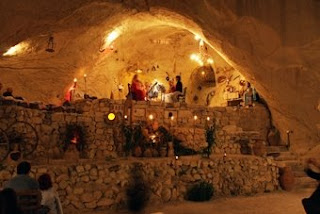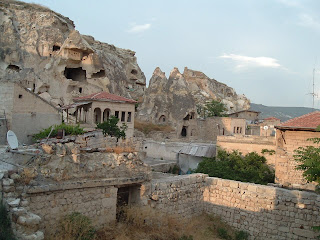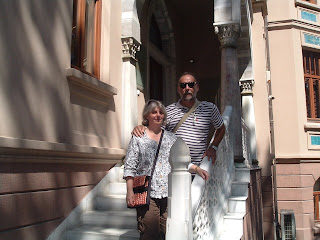 On Saturday, we were concerned about the weather, because the forecast called for a 80% chance of rain. Rain would normally be a blessing for local farmers, but for our purpose, it might mean that the concert would have to be canceled. We kept our fingers crossed as our van headed toward Sinasos (Mustafapaşa), a small town of approximately 2500 inhabitants in central Turkey, where Turks and Greeks historically lived side by side. We were scheduled to play that evening in a cave, which is located in a hidden valley. Is has been a popular tourist attraction for in the region for years – maybe it’s not so hidden!
On Saturday, we were concerned about the weather, because the forecast called for a 80% chance of rain. Rain would normally be a blessing for local farmers, but for our purpose, it might mean that the concert would have to be canceled. We kept our fingers crossed as our van headed toward Sinasos (Mustafapaşa), a small town of approximately 2500 inhabitants in central Turkey, where Turks and Greeks historically lived side by side. We were scheduled to play that evening in a cave, which is located in a hidden valley. Is has been a popular tourist attraction for in the region for years – maybe it’s not so hidden!
As we entered the area directly below the “cave stage ”, we could feel the unusual energy of this breathtaking natural geological formation, which was to be the frame for our musical picture.
With little more than an hour before concert time, we moved our instruments up the steps into the cave and arranged our chairs and stands, so we could play a few notes to observe the acoustic of the cave.
Before had finished our warm-up, we saw that people were already coming into the area to claim their seats, and some joined us inside the cave, where several seats had been placed around us.

About 45-minutes into the concert, the wind picked up and we were struggling to keep the music on our stands. This was Mother Nature’s way of telling us that we had tempted fate by taking a chance on the 20% possibility that it would not rain.
The cave was actually large enough to hold most of the audience that had not found shelter under their umbrellas and/or under the overhanging rocky ledge below the stage. Magically, the uninvited rain played an integral role in making the evening memorable. It had cleared the air and seemed to have the effect of amplifying our sound, as it radiated from the cave.
After the concert we went back to Ziggy’s Café for a meal of mezzes and raki with friends. Tomorrow would come all too soon and we would have to drive back to Ankara and fly to Izmir. Şirince would be the next stop on our concert tour.

Şirince is a quaint, scenic and quite old mountaintop Greek Orthodox village, 12 km away from Ephesus. The winding roads take the visitor through lovely peach orchards and mountainside olive groves. The olives trees are so numerous, that they appear to be growing wild everywhere, and yet, we were assured that they were well tended. Olive oil is has great commercial value in the region, and rightly so – it is very delicious!
 Our Sunday arrival and consequent performance was timed to coincide with the busy weekend tourist activity in the area. When we arrived, the cobblestone streets were shops packed with visitors. We passed an array of shops and stalls, which offered passersby everything from almonds to olive oil and local wine. There were so many racks and shelves of wine bottles on display in the full sun, that we were surprised that the merchants had anything other than vinegar to sell, and yet is was very colorful.
Our Sunday arrival and consequent performance was timed to coincide with the busy weekend tourist activity in the area. When we arrived, the cobblestone streets were shops packed with visitors. We passed an array of shops and stalls, which offered passersby everything from almonds to olive oil and local wine. There were so many racks and shelves of wine bottles on display in the full sun, that we were surprised that the merchants had anything other than vinegar to sell, and yet is was very colorful.Driving along cobblestone streets, we passed an open-air bazaar and by the Artemis Restaurant, the best in town and where we looked forward to eating after the concert.

After a few twists and turns down the narrow streets, we arrived at the Güllü Konak Hotel, a beautiful small and very elegant boutique hotel, which had opened only a year earlier.
http://www.gullukonak.com/gk/en/
This is where Doris and were given a room for the night. Ellen, Husam and Akemi would be lodged at a local family residence in the heart of the village.

We had only a short time to settle in and change before the concert. Husam would return soon to lead us up the hill on foot, to the old Greek Church (built around 1832) where we would be performing that evening.

The concert audience was near capacity. In fact, there were not enough seats accommodate the enthusiastic people who wanted to attend, and looking out into the sanctuary, as the concert progressed, we could see a crowd that had assembled in the back of the church and up in the balcony area.
The only complaints (or maybe they were compliments) were from the swallows diving down from their nest in the church ceiling. Perhaps they were happy to welcome the Audubon Quartet!


































